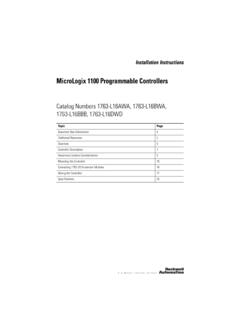Transcription of Increasing Returns and Economic Geography Paul Krugman
1 Increasing Returns and Economic Geography Paul Krugman Massachusetts Institute of Technology This paper develops a simple model that shows how a country can endogenously become differentiated into an industrialized "core" and an agricultural "periphery." In order to realize scale economies while minimizing transport costs, manufacturing firms tend to locate in the region with larger demand, but the location of demand itself depends on the distribution of manufacturing. Emergence of a core-periphery pattern depends on transportation costs, economies of scale, and the share of manufacturing in national income.
2 The study of Economic Geography -of the location of factors of pro- duction in space-occupies a relatively small part of standard eco- nomic analysis. International trade theory, in particular, convention- ally treats nations as dimensionless points (and frequently assumes zero transportation costs between countries as well). Admittedly, models descended from von Thunen (1826) play an important role in urban studies, while Hotelling-type models of locational competi- tion get a reasonable degree of attention in industrial organization.
3 On the whole, however, it seems fair to say that the study of Economic Geography plays at best a marginal role in Economic theory. On the face of it, this neglect is surprising. The facts of Economic Geography are surely among the most striking features of real-world economies, at least to laymen. For example, one of the most remark- able things about the United States is that in a generally sparsely populated country, much of whose land is fertile, the bulk of the population resides in a few clusters of metropolitan areas; a quarter of the inhabitants are crowded into a not especially inviting section of the East Coast.
4 It has often been noted that nighttime satellite [Journal of Political Economy, 1991, vol. 99, no. 3] ? 1991 by The University of Chicago. All rights reserved. 0022-3808/91/9903-0005$ 483 484 JOURNAL OF POLITICAL ECONOMY photos of Europe reveal little of political boundaries but clearly sug- gest a center-periphery pattern whose hub is somewhere in or near Belgium. A layman might have expected that these facts would play a key role in Economic modeling. Yet the study of Economic geogra- phy, at least within the economics profession, has lain largely dormant for the past generation (with a few notable exceptions, particularly Arthur [1989, 1990] and David [in press]).
5 The purpose of this paper is to suggest that application of models and techniques derived from theoretical industrial organization now allows a reconsideration of Economic Geography , that it is now time to attempt to incorporate the insights of the long but informal tradi- tion in this area into formal models. In order to make the point, the paper develops a simple illustrative model designed to shed light on one of the key questions of location: Why and when does manufactur- ing become concentrated in a few regions, leaving others relatively undeveloped?
6 What we shall see is that it is possible to develop a very simple model of geographical concentration of manufacturing based on the interaction of economies of scale with transportation costs. This is perhaps not too surprising, given the kinds of results that have been emerging in recent literature (with Murphy, Shleifer, and Vishny [1989a, 1989b] perhaps the closest parallel). More interesting is the fact that this concentration of manufacturing in one location need not always happen and that whether it does depends in an interesting way on a few key parameters.
7 The paper is divided into four sections. Section I sets the stage with an informal discussion of the problem. Section II then sets out the analytical model. In Section III, I analyze the determination of short- run equilibrium and dynamics. Section IV analyzes the conditions under which concentration of manufacturing production does and does not occur. I. Bases for Regional Divergence There has been fairly extensive discussion over time of the nature of the externalities that lead to localization of particular industries.
8 Indeed, Alfred Marshall's original exposition of the concept of exter- nal economies was illustrated with the example of industry localiza- tion. Most of the literature in this area follows Marshall in identifying three reasons for localization. First, the concentration of several firms in a single location offers a pooled market for workers with industry- specific skills, ensuring both a lower probability of unemployment and a lower probability of labor shortage. Second, localized industries can support the production of nontradable specialized inputs.
9 Third, Increasing Returns 485 informational spillovers can give clustered firms a better production function than isolated producers. (Hoover [1948] gives a particularly clear discussion of agglomeration economies.) These accounts of industry localization surely have considerable validity. In this paper, however, I shall offer a somewhat different approach aimed at answering a somewhat different question. Instead of asking why a particular industry is concentrated in a particular area-for example, carpets in Dalton, Georgia-I shall ask why man- ufacturing in general might end up concentrated in one or a few regions of a country, with the remaining regions playing the "periph- eral" role of agricultural suppliers to the manufacturing "core.
10 " The proposed explanation correspondingly focuses on generalized exter- nal economies rather than those specific to a particular industry. I shall also adopt the working assumption that the externalities that sometimes lead to emergence of a core-periphery pattern are pecuniary externalities associated with either demand or supply link- ages rather than purely technological spillovers. In competitive gen- eral equilibrium, of course, pecuniary externalities have no welfare significance and could not lead to the kind of interesting dynamics we shall derive later.



